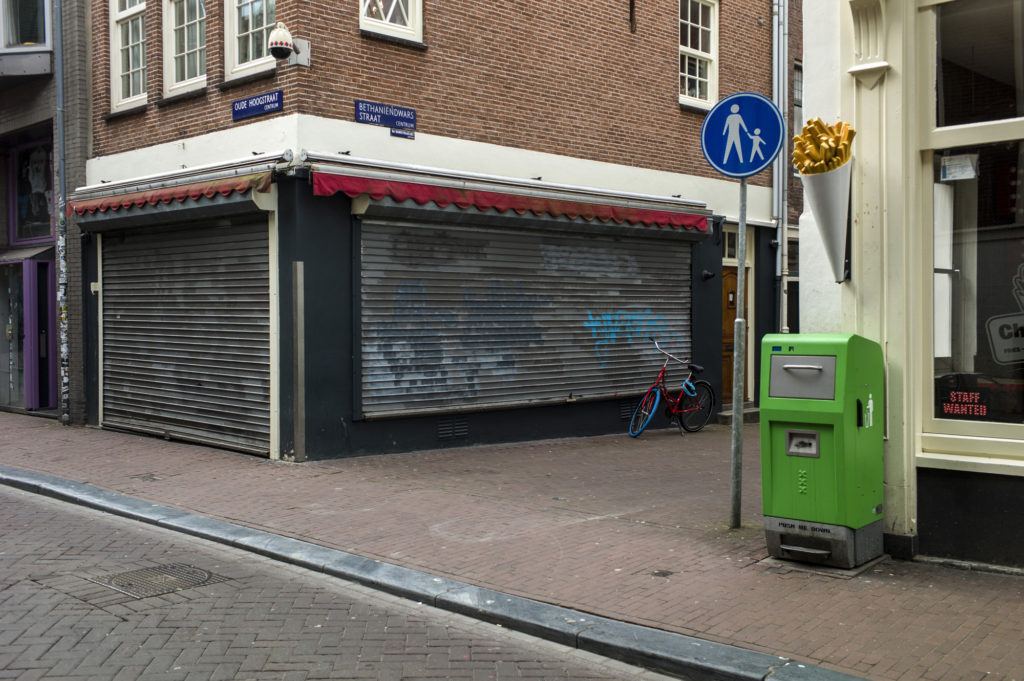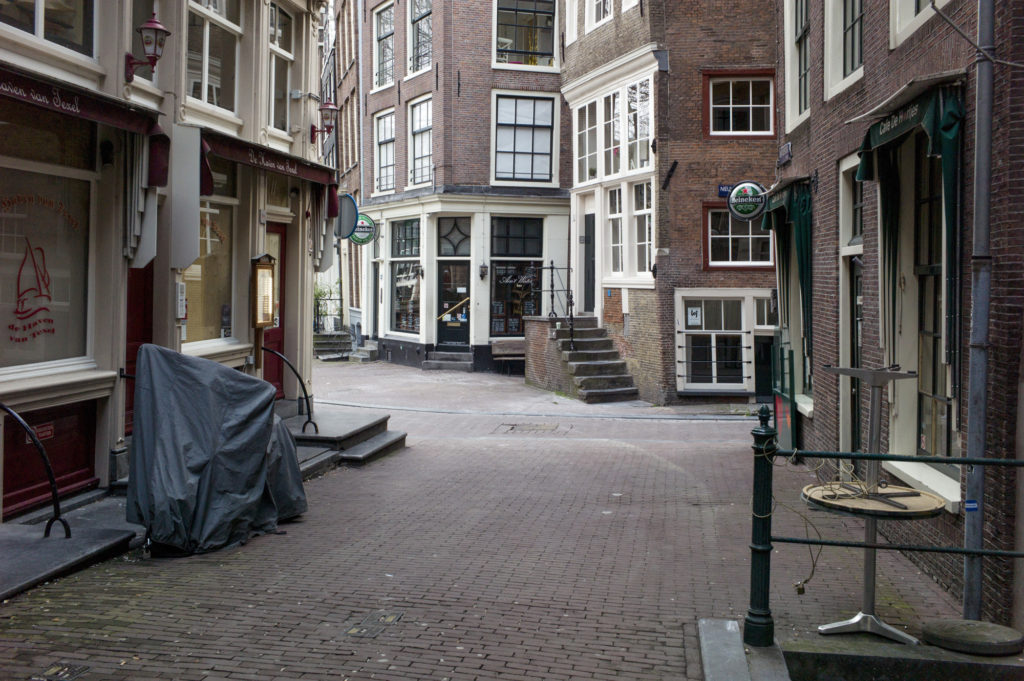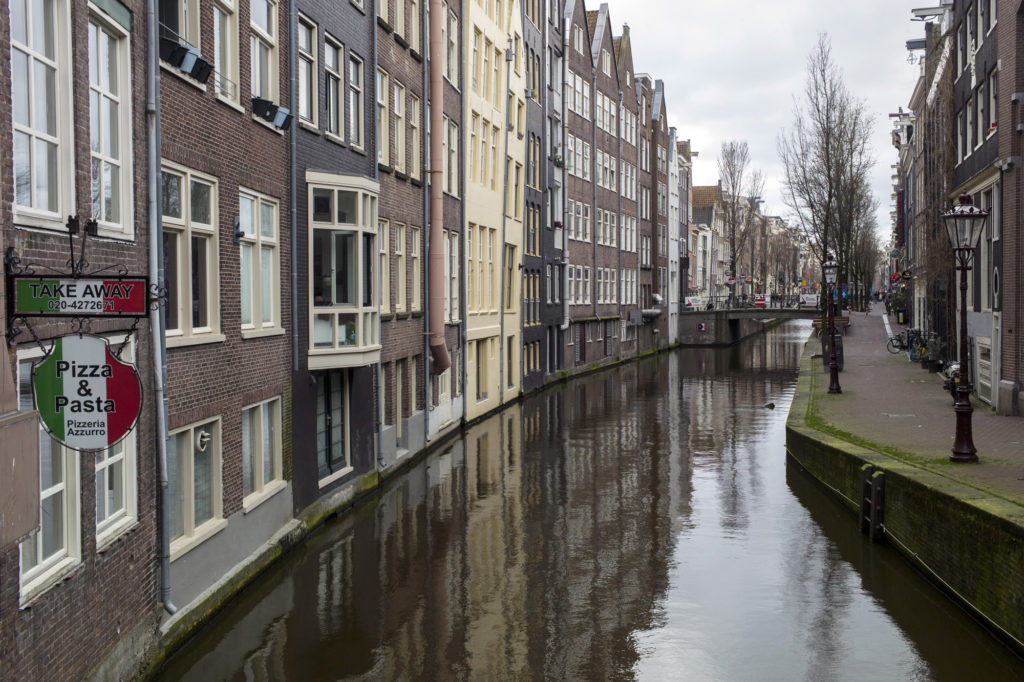Restrictions
door Caroline Vonk
The silent city
The streets were always crowded. The route from home to work led me across the Prinsengracht, past vans that stopped from Westerstraat to Hotel Wiechmann, with its collection of teapots displayed on the plinth behind the window, low to the ground, where rolling trunks and taxis passed by, and then left, into one of the Nine Streets, past a café with a queue for the best coffee ‘in town’. For months I watched a poster stuck to garbage cans and advertising columns, with a drawing of a prince wearing black glasses: ‘The prince with 349 houses. Not a fairy tale.’ And every day I passed a house of someone who had hung a poster in front of his window with the question: ‘Who the fuck is Yuppie Jordaan? And I was thinking about our place in town.
Living in a city means taking up scarce space. It starts with finding a place to live and then becomes routine, every time you close the front door behind you, finding your own way, along busy streets, intersections, squares, bus shelters, shopping streets, terraces and supermarkets. Claiming a parking spot, choosing a spot in line – living in the city, in any city, requires some assertiveness. The city dweller is adept at it: he cherishes the hustle and bustle, at the same time longs for more space and knows where to find it. In the centre of Amsterdam I know an artist with the most beautiful trees on the narrow pavement in front of her house. It started when she once planted them clandestinely – paving tile out, little tree in it – and later the city council built an upright ledge around it, for protection. That’s how you do it.

The images of Nicole Segers can also be viewed as a separate series.
Anderen vinden de ruimte in de grote draaicirkels van hun bakfietsen, in de rookwalm die vanaf hun barbecues door het park waait, in de muziek die uit hun openstaande rugzakken door de straten galmt. In burgerlijke ongehoorzaamheid die hoort bij het gevoel van vrijheid dat aan de stad kleeft. Zoals Robert Oey, echtgenoot van burgemeester Halsema, in NRC genoeglijk uit de doeken deed: op de Herengracht tegen het verkeer in fietsen, dat mag niet. ‘Maar ik doe het gewoon. Ik overtreed iedere dag de wet.’
Dat een houding als deze van anderen vraagt om juist ruimte te máken, uit te wijken, een stap opzij te doen of een eindje verderop te gaan zitten, daar hoor je niemand over.
Tot het moment dat de stad onverwacht tot stilstand kwam, de mensen zich terugtrokken in hun huizen, de straten leger werden, de parken onder toezicht kwamen, de bibliotheken, cafés, schouwburgen en musea sloten. Vooral in het centrum van de stad werd het leeg op straat en vooral daar kwam de stilte hard aan: de afwezigheid van een constante stroom bezoekers gaf de gebouwen, vaak toch al eeuwen stevig op hun plaats, een verlaten aanblik. Fotografen trokken naar buiten om het moment vast te leggen. Op de foto’s uit de serie gemaakt door de Amsterdamse fotograaf Nicole Segers, die de eerste dagen meteen door het oude centrum van de stad liep, lijken de smalle stegen zonder mensen plots zoveel breder en de schaduwen die ononderbroken over straten lopen zoveel langer. Maar bovenal zijn het de boodschappen gericht aan bewoners en bezoekers die meer dan ooit in het oog springen. Geen straat zonder naam of verkeersbord, geen gevel zonder uithangbord, geen winkelruit zonder tekst en geen deur zonder openingstijden. Voor even praat de stad in het niets.
Toch kwamen er nieuwe regels in town, ‘spelregels’, zoals de bakker in kapitale letters schreef boven de richtlijnen voor een bezoek aan zijn winkel. En een aantal maanden later blijkt het spel eindig noch vrijblijvend. De tijdelijke noodregels worden gegoten in de wet, de linten en het tape die looproutes en grenzen aangeven zullen spoedig muren en hekken zijn. Ze dicteren ons toekomstige openbare leven, maar druisen in tegen wezenlijke principes van de stad: de wervelende drukte om zomaar in op te gaan, de eigengereidheid van het individu om in de massa mee overeind te blijven.
Hoe kan het stadsleven overleven op anderhalve meter, de nieuwe orde der dingen? Wat winnen we aan bewegingsvrijheid, nu de straten leger zijn, en wat gaat daarbij onherroepelijk verloren?

The images of Nicole Segers can also be viewed as a separate series.
Others find the space in the large turning circles of their cargo bikes, in the smoke that blows through the park from their barbecues, in the music reverberating through the streets from their open backpacks. In bourgeois disobedience associated with the sense of freedom that goes with the city. As Robert Oey, husband of mayor Halsema, explained in NRC: cycling against traffic on the Herengracht is not allowed. But I’ll just do it. I break the law every day.’
You don’t hear anyone saying that an attitude like this requires others to make room, to move away, to step aside or to sit down a little further.
Until the city came to an unexpected standstill, people retreated into their homes, the streets became army, the parks came under surveillance, the libraries, cafes, theatres and museums closed. Especially in the centre of the city it became empty in the streets and especially there the silence came hard: the absence of a constant stream of visitors gave the buildings, often firmly in place for centuries anyway, a desolate appearance. Photographers went outside to capture the moment. In the photographs from the series taken by the Amsterdam photographer Nicole Segers, who walked straight through the old city centre for the first few days, the narrow alleys without people suddenly seem so much wider and the shadows that run uninterruptedly over the streets seem so much longer. But above all, it is the messages addressed to residents and visitors that catch the eye more than ever. No street without a name or traffic sign, no facade without a sign, no shop window without text and no door without opening hours. For a moment the city talks in the middle of nowhere.
Yet new rules came into town, ‘rules of the game’, as the baker wrote in capital letters above the guidelines for visiting his shop. And a few months later the game turns out to be neither finite nor noncommittal. The temporary emergency rules are poured into the law, the ribbons and tape indicating walking routes and boundaries will soon be walls and fences. They dictate our future public life, but go against the essential principles of the city: the swirling crowds of people who want to be absorbed, the wilfulness of the individual to survive in the crowd.
How can urban life survive at one and a half metres, the new order of things? What do we gain in freedom of movement, now that the streets are army, and what is irrevocably lost in the process?
Prague, September 3, 1979. It’s a warm day, a man walks through the city centre and in front of the window of an ice-cream shop he grazes an oncoming car, a woman. For a short moment they touch each other: his shoulder, wrapped in the fabric of his T-Shirt, and her shoulder, bare under a summery top. After the collision they each continue their way.
Kontakt is the title of a series of works by the Czech artist Jiří Kovanda.
Kovanda was a teenager in Prague when he saw the Soviet Union crush the freedoms of the Prague Spring. At the time, Czechoslovakian Slovaks were combative and inventive, removing telephone directories from telephone booths, sabotaging road signs and swapping house numbers, among other things. Disorientation as an act of resistance, the city upside down.
Artists of the avant-garde were looking for a similar way out. In Prague in the sixties they staged ‘happenings’, which were not yet known there at the time, behind the Iron Curtain. Unlike in the West, they were often politically charged and downright aggressive, but also by necessity barely visible. Kovanda’s work from the seventies was so subtle and so poetic that in his day it could go completely unnoticed and also failed to make art history for a long time.
Some of his actions were handed down in the form of a photo or video, while others were forever absorbed in the city noise. Two photographs of Kovanda in a subway station, taken on 3 September 1977, have been preserved. With a curly haircut and wild beard, he stands upside down on an escalator that lifts passengers up from the depths. He looks into the eyes of the people behind him, the neatly trimmed boy one step lower, somewhat lower the man in suit taking a puff from his cigarette. Also preserved was a photograph of Wenceslaus Square, taken on 19 November 1976, the place where the Velvet Revolution would eventually take place. In the middle of the shoppers, Kovanda stands still and spreads his arms widely, as if to catch the people in a large embrace.
They moved him, those encounters, collisions and near-touchings, Kovanda told them later. He wanted to draw a line between himself and his fellow city dwellers, and break through a feeling of isolation. And although he never wanted to interpret his actions as political, purely personal, they were undeniably a reaction to the spirit of the times. On the distance between the individual and the prevailing ideology that shaped public life, on the despondency of the population that drew the streets of Prague these years.
In recent years, Jiří Kovanda’s actions have been rediscovered and still make a crushing impression – even in a free society, even today. His small oeuvre expresses a deep longing for communication, for contact with other people, for an environment that consists of more than just passers-by. I am reminded of him when I content the pass with an oncoming car in my sights. In the choice: take a step aside and swerve to the street, or walk on and leave the decision to the other? And when I swerve: the look ahead or a smile to the side, as a sign of recognition?
The emotion Kovanda experienced in Prague under socialism has countless variations in the West. Observing people in the crowd, the face in the crowd, has been a typical activity for artists since modern times. From writers who look at the movement of the individual with amazement to artists who want to experience the workings of the crowd in depth. Time and time again we see how our experience of freedom breaks down into numerous inner liberties. Fiona Tan who for n.t. (Leidsestr.) (1997) stopped between the stream of people shopping and trams passing each other in the cramped Leidsestraat. The video is played at such a fast pace that the people shoot past her, but are barely recognizable. A man with a brown package under his arm, a boy with an open book, a couple who kiss each other just behind her back. The stationary Tan had become an obstacle that others had to avoid and with that she could, she told later, for a while experience what it was like to be an object.
But I am also thinking of video footage of Liza May Post who, as a student at the Gerrit Rietveld Academie in the early nineties, laid down on the ground in all sorts of places. Flat on her stomach she lay in a broken street, on a platform or on the pavement at the bottom of a staircase, her hands along her body, palms and soles of her feet facing the air, her head turned one way, like a neat corpse. The last time she laid down like this was on the floor of De Bijenkorf, across the aisle of the perfumery department. Of the visitors we mainly see their bottoms, the legs of women with skirts up to their knees and the legs of men with a fold in their trouser legs, who are frightened at the sight of the young woman and visibly hesitating: turning back or passing by. They all pass by.

Post did not opt for a subtle and fleeting gesture, as Kovanda had done before and elsewhere, but for excessive behaviour as a form to mark the boundary of personal freedom. In the glory days of consumerism and commerce – after the fall of the Wall, before 9/11 and well before corona – that was very appropriate.
Just at a time when more people than ever took to the streets around the world, united for street protest and climate march, they were startled by a virus and sent home by their government. It’s done with running into someone carelessly. The Bijenkorf may be open again, but for a limited number of visitors, from a distance, with walking routes and screens. People can come to the shop on their own as much as possible and do not want to touch products ‘unnecessarily’. Where are we going to meet each other in the future, without creating a blockade, without causing a collision?
Even with empty streets the city will turn out to be cramped, the physical space per inhabitant larger than before, but with room for fewer people. Images of street protests in Tel Aviv appeal to the imagination: two thousand people have protested there in recent weeks at a distance of two metres, with mouth caps in front of them, on a square where tens of thousands of people used to gather. And yet their presence made an impression, in the space they occupied together, arranged in rows reminiscent of pieces on a chessboard – individuals to take seriously. Hong Kong and Russia saw the first massive online protests, which of course do not make any impression on the streets, but which can strengthen mutual solidarity beyond the borders of a city. With the added advantage that they do not require permits.
We have to rearrange ourselves, that much is certain. Space is limited, but can be found everywhere – just turn around on an escalator, look someone else in the eye and take a step to the side.
Living in a city means occupying scarce available space. Until the city comes to an unexpected standstill, and people retreat.
by Roos van der Lint